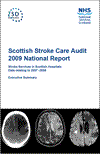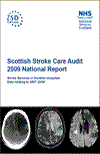Scottish Stroke Care Audit 2009 National Report: Stroke Services in Scottish Hospitals. Data relating to 2007 - 2008.
![]() Executive
Summary
Executive
Summary ![]() SSCA
Report 2010
SSCA
Report 2010
on-line version only)
Paper editions of the above are available, please contact Hazel Dodds
SSCA National Report Tables and Charts (only available on-line)
SSCA Hospital Tables - Inpatients (only available on-line)
SSCA Hospital Tables - Outpatients (only available on-line)
INTRODUCTION
There is strong evidence that well organised stroke care improves the outcome of patients having a stroke. In Scotland, the Scottish Intercollegiate Guidelines Network (SIGN) and NHS Quality Improvement Scotland (NHSQIS) have developed guidelines and standards aimed at delivering that care. New NHSQIS standards based on the new SIGN Guidelines have been published in 2009. The Scottish Stroke Care Audit monitors the quality of care provided by the hospitals in all NHS Boards by collating data collected by the Managed Clinical Networks (MCNs). These data are used by the Scottish Government Health Department to monitor progress against the NHSQIS standards for stroke and its CHD & Stroke Strategy.
NHS Boards are expected to identify aspects of their stroke services which do not meet National Standards and to work with their stroke MCNs to improve their performance. This latest National Report includes data describing the quality of stroke care in each acute hospital grouped by NHS Board from 2007 to 2008. This allows each hospital and NHS Board not only to compare their performance with national standards, but also with other organisations. Hospitals with less satisfactory performance can learn from those where services are of higher quality. This year the report also looks forward and examines hospital performance against the new standards.
KEY POINTS
Five key quality indicators are:
Proportion of stroke patients admitted to a Stroke Unit within 1
day of admission to hospital. Stroke unit care is associated with
reduced risk of dying and disability after a stroke. The current NHSQIS
standard is that at least 70% of patients should be admitted to a stroke
unit within a day of admission. In 2008 57% (2007: 56 %) of patients were
admitted to a stroke unit within one day of admission.
Proportion having a documented Swallow screen on day of admission.
About half of all stroke patients will not be able to swallow safely on
admission to hospital. If given fluids or food inappropriately patients
may develop, and possibly die from, pneumonia and if not treated appropriately
they may become dehydrated and malnourished which may lead to slowed recovery
and/or worse outcome. The current NHSQIS standard is that all patients should
have a swallow screen on the day of admission. In 2008 46% (2007:42%) of
patients had a swallow screen recorded on day of admission.
Proportion having a brain scan within 2 days of admission.
A brain scan is essential to confirm the diagnosis of stroke and to distinguish
stroke due to ischaemia (a blocked blood vessel) or a haemorrhage (burst
blood vessel). Treatments for a blocked blood vessel are very dangerous
to those with a burst blood vessel. The current NHSQIS standard is that
at least 80% should have a brain scan within 2 days of admission. In 2008
89% (2007: 87%) of patients had a brain scan within two days of admission.
Proportion of patients with ischaemic stroke who receive aspirin
within 2 days of admission. Aspirin started within the first 2
days reduces the proportion of patients having recurrent strokes and residual
disability. The NHSQIS standard is that all patients should receive aspirin
within 2 days unless contraindicated. In 2008 76% (2007: 69%) of ischaemic
stroke patients received aspirin within two days of admission.
Proportion of patients with a mini stroke (transient ischaemic attack),
who do not need immediate admission, assessed in a specialist neurovascular
clinic within 14 and 7 days of receipt of referral. The risk of
a stroke within the first week is at least 10%. Appropriate treatment can
halve this risk but only if started very early. The NHSQIS standard is that
80% should be seen within 14 days and ideally within 7 days. In 2008 81%
(2007: 65%) of patients seen in neurovascular clinics were seen within 14
days. In 2008 59% (2007: 44%) of patients seen in neurovascular clinics
were seen within 7 days.
INTERPRETATION
Good or bad performance with respect to these five indicators, and the many others available in the main report, will usually reflect the actual performance of the service. However, if the audit methodology is not strictly adhered to, the local data may be misleading – most likely they will give a reassuringly good measure of performance. For instance, if the audit does not include patients managed out with the stroke unit an overly optimistic view of the quality of the service will result. In the long run this will harm patients.
DETAILED FINDINGS
The introduction of the Stroke Strategy has been associated with significant improvement in stroke services across Scotland. However, the quality of stroke services varies greatly across Scotland. Further action is required in all NHS Boards since areas of poor performance are likely to be reflected in worse outcomes (more deaths and more disability) for their patients. In addition, poor care leads to longer lengths of hospital stay, greater residual dependency and thus higher costs to health services. No hospital meets all the NHSQIS standards, so all need to strive to improve their stroke services.
The “refreshed” stroke strategy published in June 2009 highlights many additional aspects of stroke services which need to be developed. Revised and more challenging NHSQIS standards which reflect the latest evidence included in latest stroke SIGN guidelines were published in 2009. NHS Boards will need to take account of these new standards in their planning.
This table shows the changes to current standards:
| Standard | 2004 - 2008 Standards | 2009 New Standards |
| Access to stroke unit care | 70% enter stroke unit within 1 day of admission (Day 0 or 1) | 60% on day 0 and 90% by day 1 |
| CT scanning | 80% within 2 days of admission (days 0,1 or 2) | 80% on day of admission (day 0) |
| Swallow screening | 100% on day of admission (day 0) | no change |
| Aspirin | 100% of ischaemic strokes within 2 days of admission (days 0, 1 or 2) | 100% within 1 day of admission (days 0 or 1) |
| Delay from receipt of referral to neurovascular clinic | within 14 days | within 7 days |
There are also two new standards which will require new data to be collected by SSCA. The first one is that acute stroke care should deliver thrombolysis to at least 5 per 100,000 population per year and that 80% of treated patients should start treatment within 60 minutes of arrival at hospital. The second is that 80% of carotid endarterectomies should be performed within 14 days of their last TIA or ischaemic stroke.
MAIN CONTACTS:
Martin Dennis
SSCA Clinical Lead
0131 537 1719
martin.dennis@ed.ac.uk
Hazel Dodds
SSCA Clinical Coordinator
0131 275 7184
hazeldodds@nhs.net
David Murphy
Senior Information Analyst
0131 275 6624
david.murphy2@nhs.net

